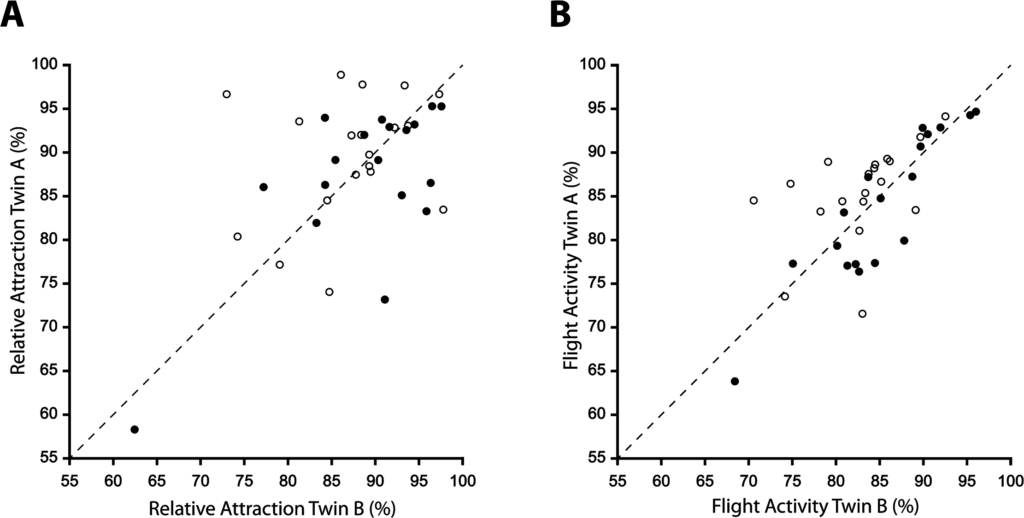Abstract
The attraction of mosquitoes can be attributed to many factors including exercising and insufficient bathing, however, scientists tested whether there is a linkage between genetics and the attractiveness of mosquitoes. Mosquitoes are attracted to certain individuals more than others due to their genetics. Scientists evaluated the mosquito attractiveness between identical and fraternal twins to determine the relationship. Results indicated a higher correlation with attractiveness between identical twins than fraternal twins which suggests that attractiveness is partially based on a genetic factor.
Introduction
Mosquitoes feed on different elements including plant sap or nectar; in order to reproduce, offspring female mosquitoes feed on blood to produce eggs and continue their life cycle and the next generation as well. Many components influence the attraction of the female mosquitoes to their hosts such as their body odor, diet, pregnancy, blood type, and body mass (Fernández-Grandon et al., 2015). These factors speculate as to why some individuals are more likely to get bitten, however, in an effort to determine whether genetics are also a factor, scientists used pairs of identical and fraternal twins to test this hypothesis. As known, identical twins share 100% of DNA due to developing from the same fertilized egg while fraternal twins share 50%. This disparity between twins can suggest the basis whether attraction of mosquitoes is contributed to genetics.
Methods and Materials
Researchers used female mosquitoes of the Aedes aegypti species in order to conduct the experiment. Using a Y-tube olfactometer (Figure 1), 18 pairs of identical twins and 19 pairs of fraternal twins were used as bait for the attraction of mosquitoes. Since the experiment focused on the genetic factor only, participants were instructed to wash their hands using odor-free soap to reduce their body odor. Immediately after, participants had to air dry their hands and were not allowed to touch anything. With each set of twins, they were asked to insert their hand on one end of the olfactometer and allow for the mosquitoes to swarm towards them. A large swarm of mosquitoes on one side of the tube indicated a strong attraction for that individual, while an equal number of mosquitoes indicated an equal attraction among the twins.

Figure 1: Y-Tube olfactometer
Results
The results were then plotted to view their correlation.

Figure 2: Plot A represents relative attraction; Plot B represents flight activity.
Identical twins (closed circles) and Fraternal twins (open circles).

Table 1: Intraclass correlations (r) and narrow-sense heritability (h2).
Discussion
By looking at the scatter plots, there is a higher correlation for identical twins than fraternal twins. In comparing the intraclass correlations, identical twins had a higher value at 0.56 compared to fraternal twins at 0.29 which is almost half the value. Similarly, for flight activity, identical twins had an intraclass correlation of 0.90 while fraternal twins showed 0.48. Compared to the fraternal twins, the correlation values of identical twins are greater which suggests that genetics are a vital role in attraction to mosquitoes. Although participants washed their hands with odor-free soap, body odor was not completely nullified and was still a factor due to the body naturally emitting chemicals. Additionally, the experiment focused solely on the individual’s hands which may lead to differences in data if the experiment was conducted on another part of the body. This experiment should be repeated again using a different species such as the Culex pipiens to compare whether results still correlate to the relationship between genetics and mosquito attraction.
Conclusion
All in all, researchers determined a higher correlation for attractiveness of mosquito establishing that genetics influence the attractiveness of mosquitoes to individuals. Since identical twins have a higher percentage of shared DNA, it was expected for the data to result in a higher correlation and was held true. After viewing the correlation of fraternal twins to attractiveness compared to identical twins, it can be inferred that if this study were done comparing identical twins to unrelated pairs of individuals, the latter would have a lesser correlation. With this in mind, the data results express the certainty that attractiveness of mosquitoes is partly determined by genetics. Further experimentation can be done comparing known factors of mosquito attractiveness such as chemicals and odors produced by the body to genetic to determine which component has a bigger impact on attractiveness. Additionally, this relationship contributes to the significance of genetics to other environmental factors. Supplementary research can lead to the understanding of other aspects that are impacted by one’s genetic information.
Reference:
Fernández-Grandon, G., Gezan, S., Armour, J., Pickett, J., & Logan, J. (n.d.). Heritability of attractiveness to mosquitoes. Retrieved February 23, 2021, from https://journals.plos.org/plosone/article?id=10.1371%2Fjournal.pone.0122716#pone-0122716-t001
Veritasium. (2018, February 7). Why Mosquitoes Bite Some People More Than Others [Video]. YouTube. https://www.youtube.com/watch?v=38gVZgE39K8&list=WL&index=22


